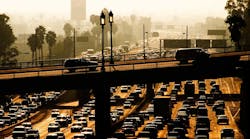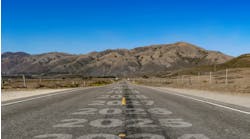(Bloomberg) — California has the toughest environmental laws in the nation but smog still shrouds Los Angeles on many days — a fact that has drawn criticism from both President Donald Trump and environmentalists.
But that’s where their agreement ends.
The president has turned California into a political punching bag, relentlessly attacking the state for unleashing “tremendous pollution” into the air and water. Environmentalists say his administration, which is trying to strip away two of the state’s weapons for fighting the problem, bears some of the blame.
“California needs to do more, and to meet clean air standards, we’re going to have to do everything,” said Adrian Martinez, a staff attorney with the environmental group Earthjustice. “But the federal government has a large role to play here as well, and under the current administration, EPA has not been helping air quality — they’ve actually been hurting it.”
The air is so bad that the state claims seven of the 10 most polluted cities for ozone according to the American Lung Association, with Los Angeles-Long Beach leading the list. Six of the 10 worst American cities for year-round particle pollution are also in California, according to the group.
California has been combating air pollution in creative ways for decades, pioneering policies that have been adopted by other states. But the fight is made harder by geography, especially in Southern California, where coastal winds trap pollution against mountains and a ceiling of warm air frequently pins it close to the ground. Wildfires also pump carbon monoxide and sooty particles into the air.
Recognizing California’s unique challenge, Congress in 1967 gave the state license to impose its own rules to bring down emissions. California regulators first took aim at tailpipe emissions — the volatile organic compounds and nitrogen oxide that spew from vehicles and then are baked by the sun into ozone, or smog. Later, the state-required automakers to employ catalytic converters and forced filling stations to keep gasoline vapors in check.
Yet decades of steady progress has stalled as motorists drive more and trucks haul freight among the states’ booming ports and warehouses.
California’s pollution troubles have made it an easy target for Trump, whose Environmental Protection Agency on Sept. 24 threatened the state’s federal highway funds if it didn’t submit new air quality plans. Two days later, the EPA accused California of allowing pollution tied to the state’s homeless population to foul nearby waterways — an allegation state authorities dispute.
The Trump administration is also making it harder for the state to clean up.
The administration has proposed freezing tailpipe greenhouse gas emissions standards and federal fuel economy requirements at 37 miles per gallon in 2020. The EPA on Sept. 19 also moved to repeal a six-year-old waiver authorizing the state’s zero-emission vehicle mandate and its own limits on tailpipe greenhouse gas emissions, which California officials maintain are essential to combat smog.
Even if federal courts restore those California programs, it won’t be enough for the state to get where it needs to go. Just to comply with Clinton administration pollution targets by a 2023 deadline, the Los Angeles basin must slash nitrogen oxide emissions another 45% — and that’s on top of reductions already projected to result from current policies, including the two Trump has targeted.
The California Air Resources Board (CARB) has homed in on cars and trucks — the chief source of the state’s pollution problems. And local air quality management districts have already attacked the low-hanging fruit at power plants, refineries and other stationary sources of pollution. State regulators, however, have little authority to require similar reductions from planes, trains and ships, which are generally under the federal government’s control.
“The major sources for pollution that we have control over are getting cleaner,” said Stanley Young, a spokesman for the air resources board that regulates cars, trucks and other mobile sources of pollution. But, he added, the major contributors of pollution in Los Angeles “are sources that only the feds have authority over, and they have done nothing to help us.”
Southern California can’t satisfy air quality requirements without significant controls on those mobile sources, said Philip Fine, a deputy executive officer of planning and rule development at the South Coast Air Quality Management District.
“There’s very little we can do on that at the local level,” Fine said. “We are being held accountable as a state for attaining the standards, but we don’t have the authority to affect the sources that are causing our non-attainment.”
Port pollution
With ships, trains and planes largely out of the state’s regulatory reach, it has pursued voluntary pacts and regulations of the facilities that serve them: airports, maritime ports and railyards. That only goes so far.
“California has begged EPA to set more stringent standards for locomotives for decades but EPA has not done so because the rest of the country does not need as stringent standards to meet clean air goals,” said Gay MacGregor, a 34-year veteran of the agency’s transportation and air quality office.
Asked for comment, EPA spokeswoman Molly Block pointed out that California has been granted waivers authorizing the state to regulate emissions from a wide variety of vehicles, including ocean-going vessels that dock at its ports. “EPA and its state and local partners continue to see substantial reductions in emissions that contribute to ozone, particulate matter and other criteria pollutants across the country,” Block said.
Tougher requirements are on the way in California for some targets. For example, CARB in June adopted a regulation to require zero-emission passenger shuttles at the largest airports. The agency is requiring public transit agencies to shift to zero-emission buses by 2040. And the South Coast air agency is aiming to propose a rule targeting warehouse emissions next year.
The state is also seeking to rein in nitrogen oxide emissions from heavy-duty diesel trucks. Both California regulators and the EPA are writing tougher requirements targeting that pollution.
Environmentalists are pushing the state to go beyond traditional regulations by making local planning decisions that discourage driving. Officials should be doing more to encourage Californians to take public transit, bike or walk, said David Pettit, a senior attorney with the Natural Resources Defense Council.
Activists say the state needs to get more aggressive where it does have control.
“Given the scope of our challenge,” Earthjustice’s Martinez said, “we really need to go to zero emissions in as many places as possible.”



